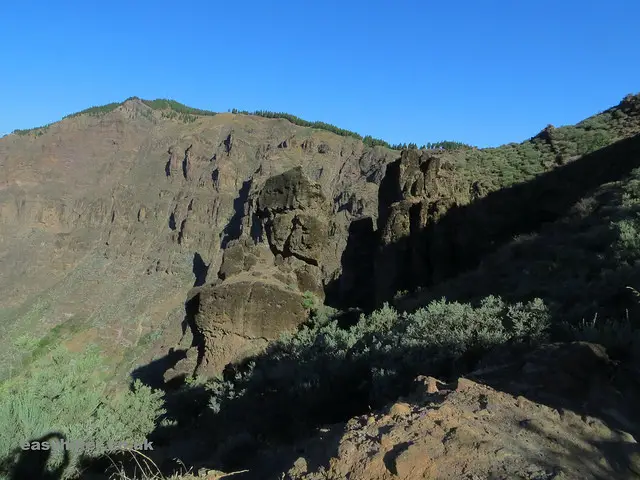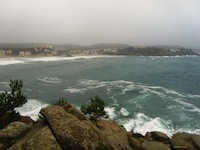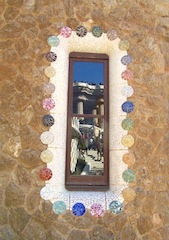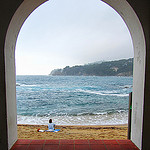Gran Canaria Walking Festival
The Little Continent Gran Canaria
Gran Canaria, they say, is a little continent in its own right – and today, having crossed the deserts of Nevada for our first hike of the Walking Festival, we will visit Utah and Arizona as well as the Californian pine forests and pass through the rainforests of Costa Rica on our way to a small village with a distinctly Mexican flavour.
But we start off in New England, or, weatherwise, one might even say in Old England: in a right pea soup of a fog, the sort in which you half suspect that Constable Dixon is hiding, passing his rubber truncheon along the iron railings of Dock Green Church.
There had been a slight mist at our base in the idyllic surroundings of the Las Calas hotel, but as our bus climbed up the mountainside, the fog just got thicker and thicker. Just when we could barely see the trees by the side of the road, a ray of sunshine peeked through the windows – and less than a minute later, the landscape all around us was bathed in the most glorious light, under immaculately azure skies.
We had broken through the haze into the land beyond the clouds.
Not enough that Gran Canaria is a continent en miniature, at this time of the year, you can also find three of the four seasons here: scorching summer heat in the lowlands, autumnal fog in the middle (at altitudes between 1000 and 1500 meters) and a bright sunny spring day in the uplands, with temperatures between 22 and 25 centigrade (mid 70s Fahrenheit). That’s quite a lot of variety for an island roughly the size of Greater London (600 square miles).
Our walk for the day started near the Cruz de Tejeda, an ancient pilgrimage site very close to the geographical centre of the island. From here, you get a stunning view across the Caldera de Tejeda, possibly the most Grand-Canyon-esque landscape you can find anywhere in Europe, and Gran Canaria’s twin speaks, the landmarks of Roque Nublo and Roque Bentayga.
We turned counterclockwise around the rim of the Caldera and then, after a mile or so, took the right path at a fork in the trail: leaving the dry air and the stony grounds of the desert behind us to step into a lush pine forest where the trees still had the moisture of that early morning’s fog on their needles.
I know it may be hard to believe but between this …
and this …
… there was, at one stage, only a narrow ridge with a width of no more than 20 metres.
How is it possible that such extreme levels of variety in climate, vegetation and precipitation exist, literally, side by side?
The reason, we were explained, is that the clouds, having been carried inland from the north, cannot cross the island’s very highest peaks – or not in great number, at any rate, because you can see how the droplets pour into the “Grand Canyon” through a gap in the stone where they almost immediately evaporate in the hot and dry desert air.
This is not quite a waterfall, more of a “cloudfall”, and if nature has a more mind-blowing spectacle to offer anywhere on this planet, I would very much love to see it.
Clouds in Gran Canaria, however, as we learned from our guides, provide more than just great theatre: they are very much the only source of water for the vegetation over here.
Proper rain is a rarity on the island which is why only those plant species can survive that are extremely well adapted – like the native pine tree, for example, that “milks the clouds” with its 20 cm long needles, extracting up to 20 litres a day.

This tree is also equipped with a protective layer of resin between bark and core that allows it to survive the frequent forest fires, withstanding temperatures of several hundred degrees for nearly an hour.
The further we climbed down from the rim of the Caldera de Tejeda, the more tropical the landscape was beginning to look, and near the end, we even spotted a little waterfall – as though this was the Amazon basin.

And all this just a few miles away from the barren slopes of “Monument Valley”!
One word of warning, however: this hike would be difficult to do on your own, outside of a guided tour, because it is not circular and you would, even if you hired a car, have to rely on some sort of public transport at some stage.
In our destination town of Valsenderos (a church, a few dozen one-storey buildings and a bar with a grumpy owner who managed to serve us cold drinks and a bowl of tapas without once taking his eyes off the wildlife programme that was playing on his giant TV screen), the buses stop twice a day. Which throws up the question: what will you do when you miss the second one?
If you had seen the town – no offense, dear Valsenderianos – this not a question you would want to contemplate.
Next time, however, I will tell you about a Gran Canaria walk that you can do on your own – it is short and sweet, just right for a day trip from Las Palmas, and can be reached conveniently by public transport. See you then!











